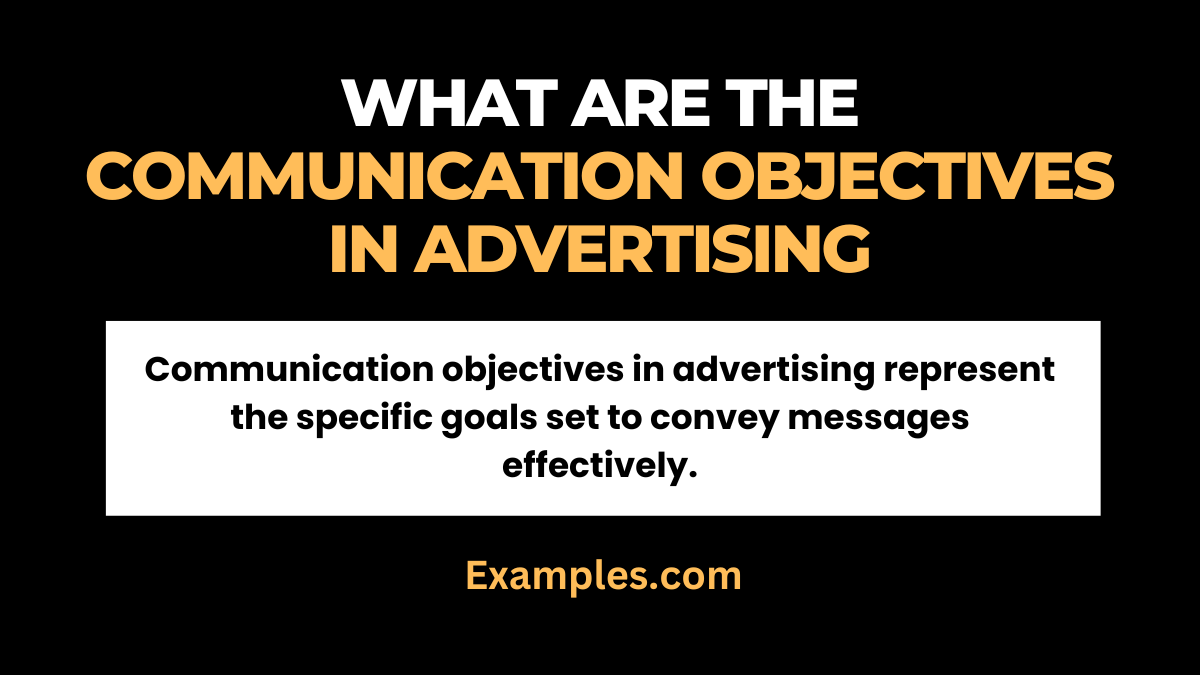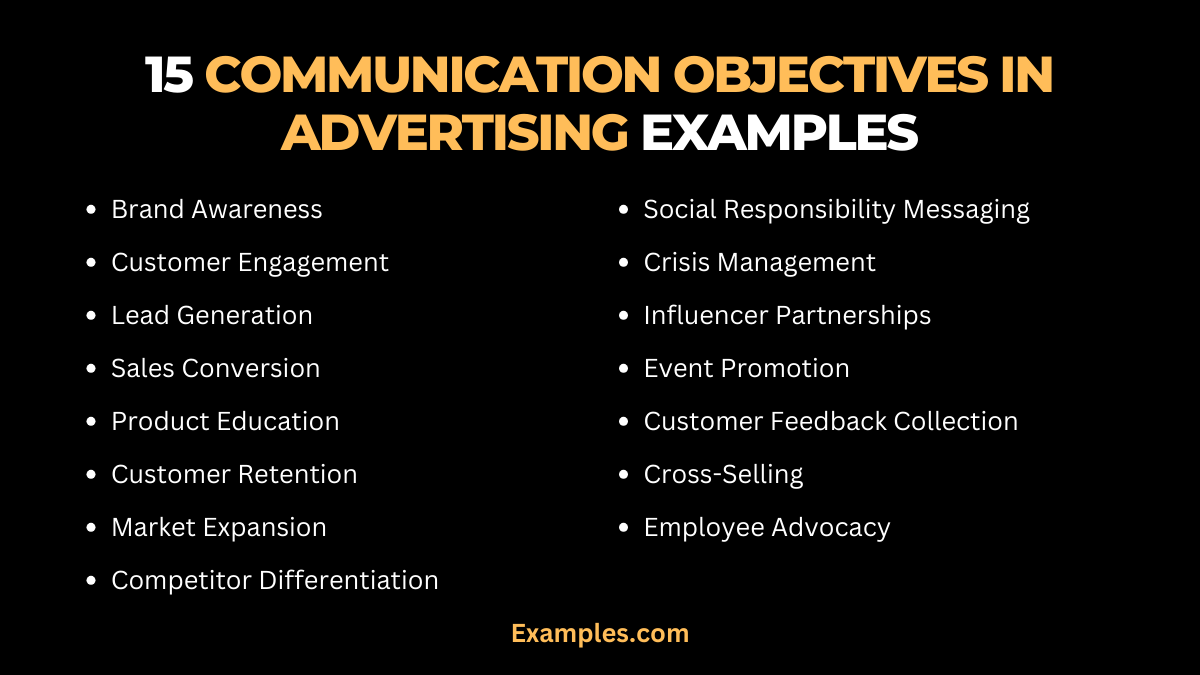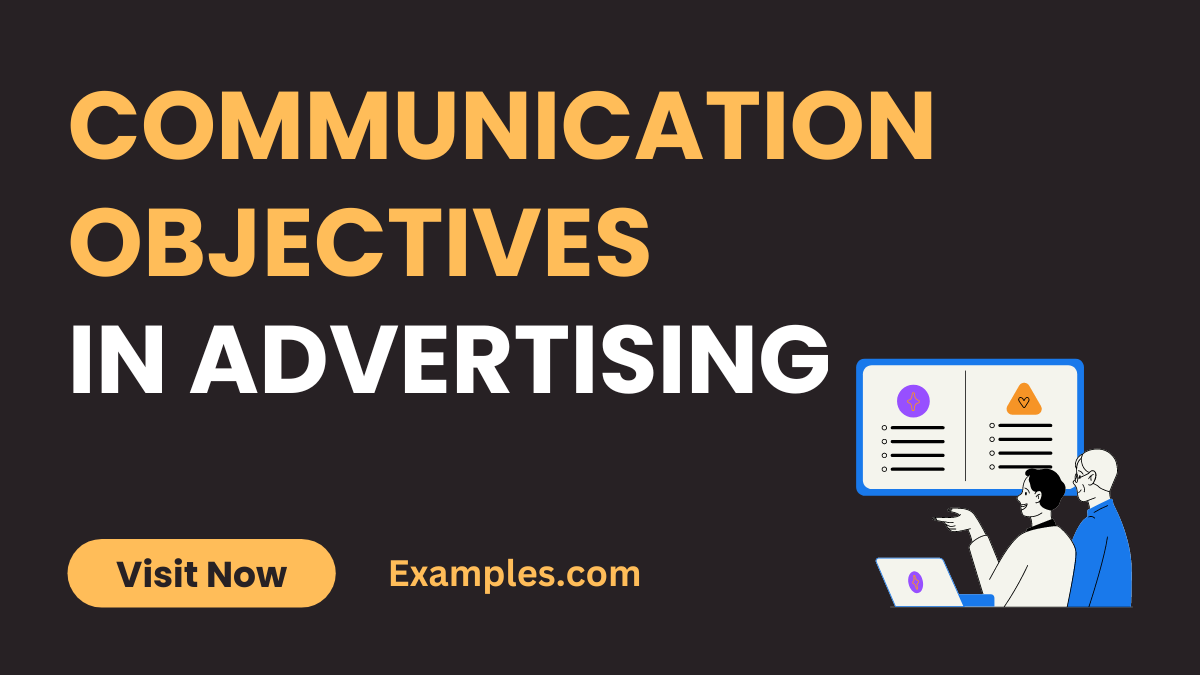14+ Communication Objectives in Advertising Examples
Embark on a transformative journey through our comprehensive guide on Communication Objectives in Advertising. This resource unveils the dynamic landscape of advertising strategies, offering practical tips and real-world communication examples that empower marketers. From building brand resonance to fostering engagement, dive into a wealth of insights to elevate your advertising endeavours and make an impact in the ever-evolving world of communication.
What are the Communication Objectives in Advertising

Communication objectives in advertising represent the specific goals set to convey messages effectively. In simpler terms, these objectives define what a brand aims to achieve through its promotional efforts. Whether building brand awareness, driving sales, or engaging audiences, these objectives serve as a roadmap, ensuring that advertising efforts resonate with the target audience, fostering success in the competitive realm of marketing.
15 Communication Objectives in Advertising Examples
Unlock the potential of advertising with 15 dynamic communication objectives. This guide navigates the intricacies of crafting compelling messages, driving engagement, and achieving marketing success. Dive into a world where communication objectives elevate campaigns, fostering brand resonance and capturing audience attention.

- Brand Awareness: Boldly showcase your logo in all marketing materials, ensuring instant recognition and recall.
- Customer Engagement: Encourage social media interaction by posing questions, fostering a sense of community and involvement.
- Lead Generation: Craft enticing landing pages that prompt visitors to share contact information, building a valuable lead database.
- Sales Conversion: Utilize compelling calls-to-action in advertisements, guiding potential customers through a seamless purchasing journey.
- Product Education: Develop informative videos showcasing product features, aiding customers in understanding utility.
- Customer Retention: Express gratitude through personalized thank-you emails, reinforcing loyalty and connection.
- Market Expansion: Tailor messaging to diverse demographics, ensuring inclusivity and broadening market reach.
- Competitor Differentiation: Emphasize exclusive features or benefits that set your product apart from competitors.
- Social Responsibility Messaging: Showcase commitment to sustainability, resonating with socially conscious audiences.
- Crisis Management: Address negative feedback promptly, demonstrating transparency and commitment to resolution.
- Influencer Partnerships: Collaborate with influencers for authentic endorsements that resonate with their followers.
- Event Promotion: Utilize social media teasers and visually appealing graphics to create buzz around upcoming events.
- Customer Feedback Collection: Implement online surveys, showcasing dedication to understanding and meeting customer needs.
- Cross-Selling: Bundle related products in promotions, enticing customers to explore additional offerings.
- Employee Advocacy: Mobilize employees as brand ambassadors, encouraging them to share company achievements on social media.
Communication Objectives in Advertising at Work
Navigate the nuanced world of workplace advertising objectives, fostering collaboration and cohesion. This guide explores strategies for conveying internal messages effectively, creating a unified and engaged work environment.
- Internal Alignment: Foster harmony among teams by communicating company goals clearly, ensuring unified efforts.
- Employee Recognition: Use internal newsletters to highlight employee achievements, promoting a positive work culture.
- Training Programs Promotion: Boldly advertise training sessions to enhance employee skills and knowledge.
- Corporate Values Reinforcement: Communicate core values through workplace posters, reinforcing a shared organizational culture.
- Employee Wellness Initiatives: Promote wellness programs via emails, encouraging a healthy work-life balance.
Communication Objectives in Advertising at a Company
Uncover the expansive realm of advertising objectives at a company level, where brand messages resonate with a broader audience. This guide delves into strategies for crafting compelling narratives that elevate the company’s brand presence.
- Brand Storytelling: Use multimedia channels to narrate the company’s journey, creating emotional connections with the audience.
- Corporate Social Responsibility (CSR): Showcase CSR initiatives through advertisements, projecting a socially responsible image.
- New Product Launch: Generate anticipation through teasers and impactful visuals for a successful product launch.
- Investor Relations Communication: Engage investors with transparent and informative communication materials.
- Market Positioning Campaigns: Boldly communicate unique selling points, differentiating the company from competitors.
What is the Main Communication Purpose of Advertising
In the vast landscape of advertising, understanding the core communication purpose is pivotal. This comprehensive guide delves into the primary objectives that drive successful advertising campaigns, unravelling the essence of why brands engage in the dynamic realm of communication.
- Conveying Information Clearly: The fundamental purpose of advertising is to convey information in a clear and concise manner. Whether it’s introducing a new product, promoting a sale, or sharing company updates, clarity ensures the message resonates with the target audience.
- Building Brand Awareness: Advertising serves as a powerful tool for building brand awareness. By consistently exposing the audience to a brand’s messaging, visuals, and values, it cultivates recognition and familiarity, laying the groundwork for brand loyalty.
- Driving Consumer Engagement: Engagement is a key objective of advertising. Whether through interactive content, social media campaigns, or other strategies, fostering consumer engagement creates a dynamic relationship between the brand and its audience.
- Eliciting Desired Actions: From making a purchase to signing up for a newsletter, advertising aims to prompt specific actions from the audience. Crafting compelling calls-to-action is essential for guiding consumers through the desired journey.
- Differentiating from Competitors: In a crowded market, standing out is imperative. Advertising communicates what makes a brand unique, emphasizing key differentiators that set it apart from competitors.
What Type of Communication is Used in Advertising?
In the dynamic world of advertising, the choice of communication is pivotal. Understanding the types of communication employed enhances a marketer’s ability to convey messages effectively. This comprehensive guide explores various communication types prevalent in advertising, providing insights into crafting impactful campaigns that resonate with diverse audiences.
- Verbal Communication in Advertising: Verbal communication relies on spoken or written words to convey messages. In advertising, it manifests in scripts, slogans, and voiceovers. Crafting clear and compelling verbal messages is crucial for audience understanding and recall.
- Nonverbal Communication Strategies: Nonverbal elements such as visuals, colours, and symbols play a pivotal role in advertising. Understanding the psychological impact of nonverbal cues enables marketers to evoke specific emotions and create memorable brand associations.
- Visual Communication Tactics: Images, graphics, and videos are powerful tools in advertising. Visual communication engages audiences instantly, making it imperative to choose visuals that align with the brand message and evoke the desired response.
- Interactive Communication in Digital Advertising: Interactive elements like quizzes, polls, and clickable content foster engagement in digital advertising. Leveraging interactive communication keeps audiences actively involved, enhancing the overall user experience.
- Emotional Appeal in Advertising: Emotional communication aims to connect with audiences on a personal level. By tapping into emotions like joy, nostalgia, or empathy, advertisers create lasting impressions and build strong emotional connections with consumers.
- Storytelling as a Communication Tool: Storytelling transcends traditional advertising by weaving narratives that resonate with audiences. Narratives create memorable experiences, making the brand more relatable and fostering a deeper connection with consumers.
- Cross-Cultural Communication Considerations: In global advertising, understanding cultural nuances is vital. Tailoring communication to diverse cultures ensures messages are received positively and avoids potential misinterpretations.
- Integrated Marketing Communication (IMC): IMC involves coordinating various communication channels to convey a unified brand message. Aligning advertising efforts across platforms ensures consistency and reinforces the brand image.
- Digital Communication Platforms: In the digital age, advertising extends across social media, websites, and apps. Tailoring communication to suit each platform optimizes reach and engagement, catering to the preferences of diverse online audiences.
- Ethical Communication Practices: Maintaining ethical standards is paramount in advertising. Transparent and honest communication builds trust with consumers, contributing to a positive brand reputation.
In conclusion, mastering communication objectives in advertising is the key to crafting compelling messages that resonate with diverse audiences. This guide has unraveled the intricacies of various communication types, from verbal and nonverbal to interactive strategies. Armed with insights and real-world examples, advertisers can navigate this dynamic landscape, creating impactful campaigns that leave a lasting impression and drive success in the competitive world of advertising.



